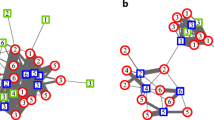Abstract
A group of hybrid baboons between anubis and hamadryas named the Gorge group was studied for five months in the Awash Valley, Ethiopia. Both morphologically and genetically, anubis features were prevalent in the Gorge group. Three types of subgroups within the group were distinguished: one-male groups, pair groups, and multi-male groups. The joining and parting of subgroups is examined by cluster-analysis. The Gorge group is concluded to be a single social unit, though it was composed of two main clusters. Grooming relations, spacing mechanisms, and sexual relations among its members were analyzed in detail. The dominance relationships among males are clarified in order to be related with their social interactions. Various aspects of the social organization are compared with those of anubis or hamadryas. It is demonstrated that the social structure of the Gorge group showed an intricate mixture of anubis and hamadryas characteristics. It is discussed how such a structure had been formed through hybridization, and what were the factors causing the differences among three types of subgroups.
Similar content being viewed by others
References
Aldrich-Blake, F. P. G., T. Bunn, R. Dunbar, &P. Headley, 1971. Observations on baboons,Papio anubis, in an arid region in Ethiopia.Folia primat., 15: 1–35.
Altmann, S. A. &J. Altmann, 1970.Baboon Ecology: African Field Study. Univ. of Chicago Press, Chicago.
Bernstein, I. S., 1966. Naturally occurring primates hybrid.Science, 154: 1559–1560.
————, 1968. Social status of two hybrids in a wild troop ofMacaca irus.Folia primat., 8: 121–131.
Chance, M. R. A., 1967. Attention structures as the basis of primate rank orders.Man, 2: 503–518.
Dunbar, R. I. M. &P. Dunbar, 1974. On hybridization betweenTheropithecus gelada andPapio anubis in the wild.J. Human Evol., 3: 187–192.
Fooden, J., 1964. Rhesus and crab-eating macaques: Intergradation in Thailand.Science, 143: 363–365.
Hall, K. R. L. &I. DeVore, 1965. Baboon social behavior. In:Primate Behavior: Field Study of Monkeys and Apes,I. DeVore (ed.), Holt, Rinehart & Winston, New York, pp. 53–110.
Hanby, J. P., 1975. The social nexus: Problems and solutions in the portrayal of primate social structure.Proceed. 5th Cong. Int. Primat. Soc., Japan Science Press, Tokyo, pp. 25–42.
Hausfater, G., 1975.Dominance and Reproduction in Baboons (Papio cynocephalus):A Quantitative Analysis. Contributions to Primatology, Vol. 7, Karger, Basel.
Kawai, M., 1958. On the rank system in a natural group of Japanese monkey (I): The basic and dependent rank.Primates, 1: 111–130.
————, 1976. Hybridization and evolution of primates (II): Speciation and hominization.Shizen, 31(12): 64–73. (in Japanese)
Kummer, H., 1968.Social Organization of Hamadryas Baboons: A Field Study. S. Karger, Basel and Univ. of Chicago Press, Chicago.
————, 1971.Primate Societies: Group Techniques of Ecological Adaptation. Aldine-Atherton, Inc., Chicago.
————, 1973. Dominance versus possession: An experiment on hamadryas baboons.Proceed. 4th Int. Congr. Primat., Vol. 1:Precultural Primate Behavior, Karger, Basel. pp. 226–231.sc————
————, 1970. Cross-species modification of social behavior in baboons. In:Old World Monkeys: Evolution, Systematics, and Behavior,J. R. Napier &P. H. Napier (ed.), Academic Press, London, pp. 351–363.
————, ————, & ————, 1974. Triadic differentiation: An inhibitory process protecting pair bonds in baboons.Behaviour, 49: 62–87.
Maples, W. R., 1972. Systematic reconsideration and revision of the nomenclature of Kenya baboons.Amer. J. phys. Anthrop., 36: 9–20.
Morgan, B. J. T., M. J. A. Simpson, J. P. Hanby, &J. Hall-Craggs, 1976. Visualizing interaction and sequential data in animal behavior: Theory and application of cluster-analysis methods.Behaviour, 59: 1–43.
Nagel, U., 1971. Social organization in a baboon hybrid zone.Proceed. 3rd Int. Congr. Primat., Vol. 3., Karger, Basel, pp. 48–57.
————, 1973. A comparison of anubis baboons, hamadryas baboons and their hybrids at a species border in Ethiopia.Folia primat., 19: 104–165.
Nishida, T., 1970. Social behavior and relationship among wild chimpanzees of the Mahali mountains.Primates, 11: 47–87.
Packer, C., 1977. Intertroop transfer and inbreeding avoidance inPapio anubis. Doct. Dissertation, Univ. of Sussex.
Sade, D. S., 1967. Determinants of dominance in a group of free-ranging rhesus monkeys. In:Social Communication among Primates,S. A. Altmann (ed.), Univ. of Chicago Press, Chicago, pp. 99–114.
Shotake, T., K. Nozawa, &Y. Tanabe, 1977. Blood protein variations in baboons: I. Gene exchange and genetic distance betweenPapio anubis, Papio hamadryas, and their hybrid.Japan J. Genetics, 52(3): 223–237.
Struhsaker, T. T., 1970. Phylogenetic implications of some vocalizations ofCercopithecus monkeys. In:Old World Monkeys: Evolution, Systematics, and Behavior,J. R. Napier &P. H. Napier (ed.), Academic Press, London, pp. 365–405.
Tokuda, K., 1961. A study of the sexual behavior in the Japanese monkey troop.Primates, 3: 1–40.
Author information
Authors and Affiliations
About this article
Cite this article
Sugawara, K. Sociological study of a wild group of hybrid baboons betweenPapio anubis andP. hamadryas in the Awash Valley, Ethiopia. Primates 20, 21–56 (1979). https://doi.org/10.1007/BF02373827
Received:
Accepted:
Issue Date:
DOI: https://doi.org/10.1007/BF02373827




